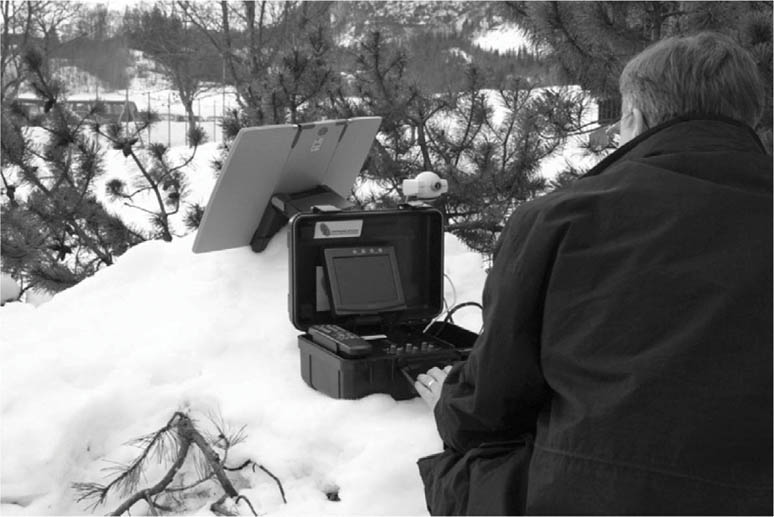Video-conferencing and videophones
Video-conferencing is the technique for enabling two-way video, audio and data signals, at relatively low quality, to be used for live interaction over a communications circuit. Video-conferencing is used either on a one-to-one basis, or by groups of people who gather in a specific setting (often a conference room) to communicate with others. As mentioned earlier, we have seen the development of ruggedized video-conferencing units designed for newsgathering to be used in the field – the videophone.
Videophones
The videophone is essentially a video-conferencing unit adapted for field use. Certainly, the quality of transmission cannot match normal SNG equipment, but the videophone’s key advantage is that it is relatively easy to set up and tote around. The videophone unit used by many TV reporters weighs less than 5 kg and connects to a camera and one or two Inmarsat GAN satphones for live transmission of pictures. The whole system is carried in five laptop-size bags, can take an experienced operator less than 10 min to set up, and be powered via a car’s cigarette lighter.
In the Iraq conflict in 2003, we saw widespread use of videophones by ‘embedded’ reporters working with front-line military units. But a particular incident in the Afghan conflict a few years earlier clearly illustrates the advantages and power of the videophone.
In November 2001 during the Afghanistan conflict, CNN correspondent Nic Robertson crossed into Taliban-controlled territory and within minutes was reporting live on the air, bringing news to the world from Afghanistan. After gathering the news on the ground and interviewing a Taliban military commander, he did not want to wait. Because the Taliban had set up strict reporting restrictions, the CNN crew smuggled videophones past border guards, enabling them immediately to broadcast footage from their hotel balcony against the backdrop of Kabul. Although images from the videophone are of lower quality than those from ‘conventional’ SNG uplinks, the videophone allowed CNN to broadcast scenes of the war almost half an hour earlier than rival broadcasters who drove to an SNG uplink facility to send their reports.
While the images are not of true broadcast quality, videophones have become popular with journalists travelling light. The videophone first became famous in April 2001, when CNN used it to broadcast exclusive live footage of a US spy plane crew leaving Hainan Island in China after having been held hostage.
They may not have been the world’s greatest pictures, but they were live. The images were jerky because the reporter pointed the camera at the runway to capture the plane’s tyres leaving the ground. Often called the Talking Head (named after the pioneering manufacturer’s model), the videophone was designed to provide live pictures of a correspondent’s moving head on a straight PTC mid-shot, not varying and moving TV footage.
The system typically consists of two units – the ruggedized field unit (the videophone) and a studio unit. The system can actually send video and audio in both directions at the same time, so a reporter cannot only hear the studio but he/she can also see the studio output too. The system can either use one ISDN circuit to operate at 64 kbps, or by making two calls, operate at 128 kbps so giving higher quality. The higher data rate allows the system to cope with more movement in the picture, or if desired improve the audio quality to studio standard (48 kbps rather than 16 kbps) in lieu of a smaller improvement in the picture quality.
So how is this equipment set up? At the receive end in the studio, you need an ISDN line and the studio transceiver. In the field you need one of the following combinations:
• A single Inmarsat GAN satphone which provides an ISDN interface but is only capable of single channel operation so you can only connect at 64 kbps.
• Any two Inmarsat GAN satphones each of which can provide 64 kbps and a videophone which split the two channels of a 128 kbps ISDN-2 call across two single channel ISDN connections, i.e. two satphones.
At least one satphone manufacturer makes a dual channel GAN (although it is very bulky) and another has an interconnecting cable between the two satphones – in both cases a videophone can make 128 kbps calls.
As we know, TV operates at 25 or 30 fps, and video-conferencing that operates at a true speed of 15 fps or greater looks acceptable for most users. If operating at rates as low as 10 fps, picture jitter is noticeable, and a person speaking will show an apparent lack of continuity.
The videophone will, once the call is connected, typically take 5–10 s for each end of the link to synchronize and connect.
Videophone in use (© 7E Communications Ltd)

